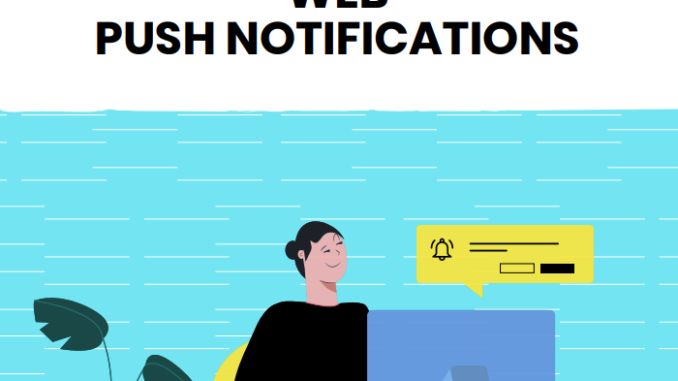
30-second summary:
Washington-based iZooto provides technology to help businesses retarget their website visitors with personalized web push notifications.
Web push notifications allow companies to leverage their website traffic by sending alerts through a user’s browser or mobile device to past visitors.
Timing is everything when it comes to push notifications. You can send notifications so that they occur immediately based on actions or triggers, or schedule them in advance.
As with most types of outbound marketing, identifying and understanding your audience is key to sending out effective messages. This helps ensure you get the best response rate while not isolating or annoying your users.
For detailed information about how web push notifications work including best practices and what to avoid, download iZooto’s The Ultimate Guide to Web Push Notifications, from ClickZ.
Founded in 2016, Washington-based iZooto provides technology to help businesses retarget their website visitors with personalized browser and app notifications, otherwise known as “web push notifications.”
Web push notifications allow companies to leverage their website traffic by sending alerts through a user’s browser or mobile device to past visitors. Push notifications can be incredibly effective, with an 80% market reach and clickthrough rates that typically average more than 7x higher than email.
iZooto’s comprehensive guide provides a detailed overview of exactly what web push notifications are and how they’re used, including best practices and common pitfalls.
In this post, we’ll cover some key insights gleaned from iZooto’s The Ultimate Guide to Web Push Notifications, which is available for download from here.
Content created in partnership with iZooto.
A brief overview of web push notifications
Web push notifications are initiated via an opt-in prompt in the user’s browser. Users simply click “allow” to opt in. The following push notification prompt is an example that appears in a Chrome browser from Techopedia.com, an iZooto customer:
Source: technopedia.com
Once the user opts in, notifications are delivered through a desktop user’s browser or natively within the user’s operating system even if they’re not on your website.
Supported browsers and operating systems include Firefox, Safari, Chrome, Linux, Windows, MacOS, and Android. Currently, Apple iOS does not support push notifications.
After a user subscribes to a website’s push notifications, they will begin receiving the notifications as they surf the web or use their mobile device.
Once a user subscribes, a unique registration key is generated by the user’s browser. A notification service like iZooto stores the keys within their platform along with additional data points that help identify each subscriber.
The six elements of a browser push notification
There are six key elements of browser push notifications, as follows:
Title
Description
Landing page URL
Icon
Banner image
Call-to-action button
Source: iZooto
Marketers can use push notifications to better leverage their website traffic, just as they would with retargeted ads, by keeping the following in mind:
What? Push notifications are an excellent mechanism to amplify and promote your content, but it’s important to have copy and creative ready to go that is meaningful to your audience.
When? Timing is everything when it comes to push notifications. You can send notifications so that they occur immediately based on actions or triggers, or schedule them in advance.
Who? As with most types of outbound marketing, identifying and understanding your audience is key to sending out effective messages. This helps ensure you get the best response rate while not isolating or annoying your users.
According to iZooto, there is a right way to ask permission from users for notifications. Waiting for users to show intent prior to asking permission and using custom opt-in prompts are both important strategies when building a web push notification list.
Per iZooto, “A custom prompt also has an additional value. It allows you to explain the value of enabling web push and gives you the option of prompting again if the user declines.”
Creating successful push notifications
Subscription opt-in rates for notifications range from about 5 to 10% of total unique visitors, but there are currently no standard clickthrough rate benchmarks since response rates depend on several factors including content, timing, target audience, and frequency.
iZooto recommends targeted notifications versus “mass broadcast” campaigns which ensures that subscribers receive the most relevant messaging. The guide lists five best practices that can help marketers achieve more success when implementing web push notifications.
Here’s an overview of three:
Personalization: Personalized push notifications perform much better than broader messages because they appeal to specific segments based on past user behavior, thus are more targeted and relevant.
Call-to-action: Adding a call-to-action button to your push notification helps provoke a response from the user, just as it would with most paid media (e.g., Facebook/Google ads).
Images: Notifications that include images are more likely to gain your subscribers’ attention and motivate them to respond.
iZooto lists some common “don’ts” when using web push notifications such as avoiding the temptation to send notifications too frequently, not relying on native op-in prompts, and not giving too much away.
Per iZooto, “Push notifications are meant to drive users to click and engage, so they aren’t ideal for explaining the finer points of your offer. Instead, you can link to the landing page.”
For more detailed information about how web push notifications work, best practices, and what to avoid, download iZooto’s new guide from here.
The post A comprehensive guide to understanding web push notifications appeared first on ClickZ.
Source: ClickZ
Link: A comprehensive guide to understanding web push notifications


